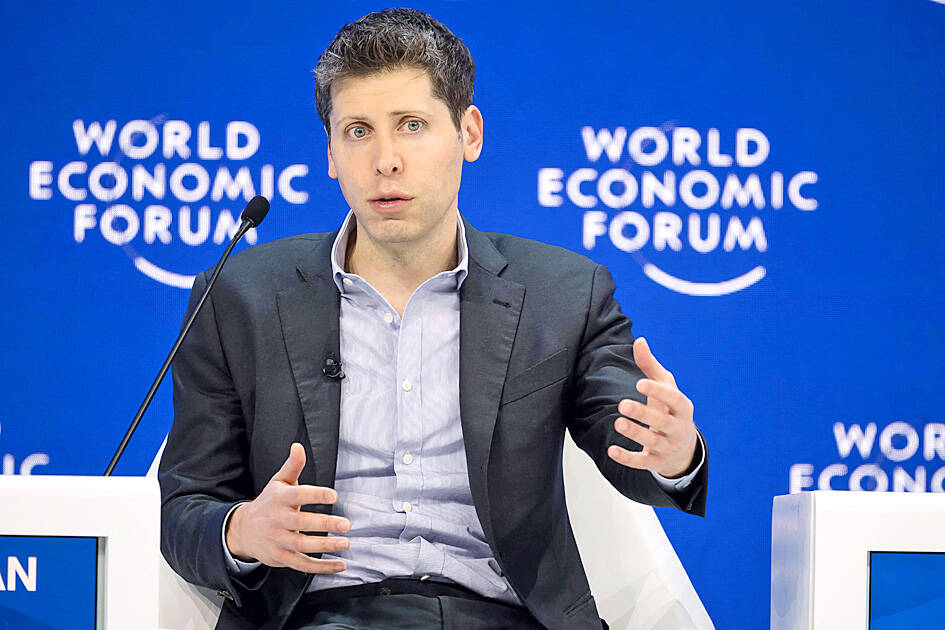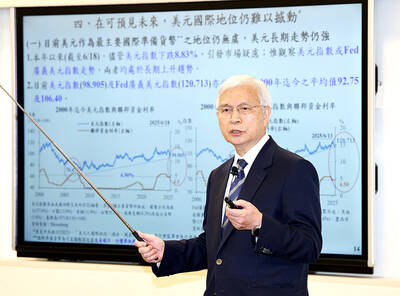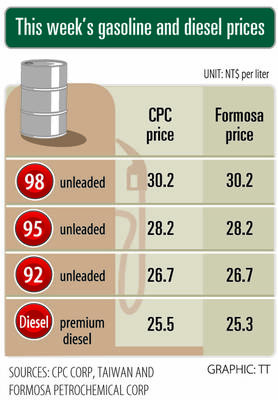OpenAI CEO Sam Altman, who has been working to raise billions of dollars from global investors for a chip venture, aims to use the funds to set up a network of factories to manufacture semiconductors, several sources with knowledge of the plans said.
Altman has had conversations with several large potential investors in the hopes of raising the vast sums needed for chip fabs, they said.
Firms that have held discussions with Altman include Abu Dhabi-based G42, sources told Bloomberg last month, with another named firm being Softbank Group Corp, some of them added.

Photo: AFP
The project would involve working with top chip manufacturers, and the network of fabs would be global in scope, they said.
While efforts to raise funds for a chip venture were earlier reported by Bloomberg, the scope of the project and the focus on manufacturing were not previously known. The talks are still early and a full list of involved partners and funders has not been established, the sources said.
Altman’s fundraising push reflects his concern that as artificial intelligence (AI) becomes more pervasive, there would not be enough chips for widespread deployment, some of the sources said. Some current forecasts for the production of AI-related chips fall short of projected demand.
Building and maintaining fabs that manufacture semiconductors is far more expensive than the approach favored by many of OpenAI’s industry peers. Amazon.com Inc, Alphabet Inc’s Google and Microsoft Corp — OpenAI’s largest investor — typically focus on designing their own custom silicon and then farm out manufacturing to outside companies.
Constructing a single state-of-the-art fab could require tens of billions of dollars, and creating a network of such facilities would take years. The talks with G42 alone had focused on raising US$8 billion to US$10 billion, sources told Bloomberg previously, although the status of the discussions remains unclear.
Altman believes the industry needs to act now to ensure that there is sufficient supply near the end of the decade, sources familiar with his thinking said.
Since OpenAI released ChatGPT more than a year ago, interest in AI applications has skyrocketed among companies and consumers. That in turn has spurred massive demand for the computing power and processors needed to build and run those AI programs. Altman has said repeatedly that there are not enough chips for his company’s needs.
Intel Corp, Taiwan Semiconductor Manufacturing Co (台積電) and Samsung Electronics Co lead the chip fabrication market and are potential partners for OpenAI.
Altman had been hard at work on the chips project until he was temporarily ousted as OpenAI CEO in November last year. Upon his return, he rekindled the efforts. Altman has also sounded out Microsoft on the plan, and the software giant is interested, two sources said.
Meanwhile, G42 has been the subject of calls this month by a key US lawmaker for greater scrutiny and trade restrictions.
US House China Select Committee Chairman Mike Gallagher, a Republican from Wisconsin, raised concerns about G42’s relationships with blacklisted Chinese companies including Huawei Technologies Co (華為) and Beijing Genomics Institute, as well as risks to research at US universities. Gallagher urged US Secretary of Commerce Gina Raimondo to consider sanctions on G42 and 13 of its subsidiaries and affiliates.

DIVIDED VIEWS: Although the Fed agreed on holding rates steady, some officials see no rate cuts for this year, while 10 policymakers foresee two or more cuts There are a lot of unknowns about the outlook for the economy and interest rates, but US Federal Reserve Chair Jerome Powell signaled at least one thing seems certain: Higher prices are coming. Fed policymakers voted unanimously to hold interest rates steady at a range of 4.25 percent to 4.50 percent for a fourth straight meeting on Wednesday, as they await clarity on whether tariffs would leave a one-time or more lasting mark on inflation. Powell said it is still unclear how much of the bill would fall on the shoulders of consumers, but he expects to learn more about tariffs

NOT JUSTIFIED: The bank’s governor said there would only be a rate cut if inflation falls below 1.5% and economic conditions deteriorate, which have not been detected The central bank yesterday kept its key interest rates unchanged for a fifth consecutive quarter, aligning with market expectations, while slightly lowering its inflation outlook amid signs of cooling price pressures. The move came after the US Federal Reserve held rates steady overnight, despite pressure from US President Donald Trump to cut borrowing costs. Central bank board members unanimously voted to maintain the discount rate at 2 percent, the secured loan rate at 2.375 percent and the overnight lending rate at 4.25 percent. “We consider the policy decision appropriate, although it suggests tightening leaning after factoring in slackening inflation and stable GDP growth,”

Greek tourism student Katerina quit within a month of starting work at a five-star hotel in Halkidiki, one of the country’s top destinations, because she said conditions were so dire. Beyond the bad pay, the 22-year-old said that her working and living conditions were “miserable and unacceptable.” Millions holiday in Greece every year, but its vital tourism industry is finding it harder and harder to recruit Greeks to look after them. “I was asked to work in any department of the hotel where there was a need, from service to cleaning,” said Katerina, a tourism and marketing student, who would

i Gasoline and diesel prices at fuel stations are this week to rise NT$0.1 per liter, as tensions in the Middle East pushed crude oil prices higher last week, CPC Corp, Taiwan (台灣中油) and Formosa Petrochemical Corp (台塑石化) said yesterday. International crude oil prices last week rose for the third consecutive week due to an escalating conflict between Israel and Iran, as the market is concerned that the situation in the Middle East might affect crude oil supply, CPC and Formosa said in separate statements. Front-month Brent crude oil futures — the international oil benchmark — rose 3.75 percent to settle at US$77.01